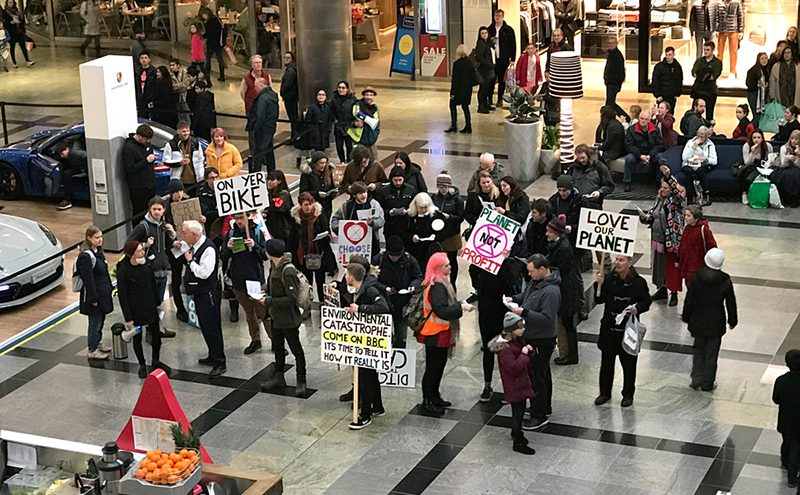
The government’s new Clean Air Strategy, announced on 14 January, made noises that suggested a bolder, more conscientious approach to tackling the public health crisis of air pollution. But it was widely decried as lacking initiative, particularly in its seeming reluctance to tackle diesel cars and pollution from the transport sector.
Seemingly significant was the declared intention to go beyond EU rules, and meet the more demanding requirements of World Health Organisation (WHO) standards. Along these lines, the document said the government were proposing “tough new goals” to cut public exposure to particulate matter pollution.
Other notable measures included restrictions on farmers’ use of fertilizer, a phasing-out of the use of coal for household open fires, and moves to prohibit the sale of the more polluting types of biomass fires.
The document was presented as a complement to the government’s Industrial Strategy, Clean Growth Strategy and 25 Year Environment Plan.
Ducking the diesel issue?
Many commentators lamented a lack of ambition with respect to curbing traffic pollution. In particular, it seemed Therese May was unwilling to bow to pressure to bring forward the ban on new petrol and diesel cars from 2040 to 2032. The ban was announced in October, to curb the build-up of nitrogen oxide pollutants in cities. By dismissing calls to advance the timetable of this ban, the government was criticised for failing to prioritise public health.
Mayor of London Sadiq Khan said: “We still desperately need a nationwide scrappage fund to take the most polluting vehicles off our streets and additional powers in a new Clean Air Act so that city leaders can tackle all sources of air pollution.”
He said London had been moving ahead with hard-hitting measures like the ultra-low-emission zone (to be introduced in April) but “we can’t win this battle without more help from the Government, who are still failing to offer the support London needs to tackle this public health crisis.”
The Institution of Mechanical Engineers’ head of engineering, Jenifer Baxter, also lamented the apparent soft-pedalling on transport emissions. “We need legally binding commitments, particularly for transport and energy systems, that could help improve the quality of the air we breathe across the UK. Local authorities have already been given responsibility for tackling roadside nitrogen dioxide concentrations, but we need to be making a determined effort to deal with transport emissions more broadly.
The strategy document appeared to place more of the responsibility for dealing with air pollution on local authorities’ shoulders, and to be equipping them with greater power “to take action in areas of high pollution.” There seemed to be an emphasis on encouraging neighbouring local authorities to work together to tackle the problem collectively, a traditional weakness cited in the document.
One network of local government leaders, UK100, bemoaned a lack of financial support. Polly Billington, Director of UK100, said: “Plans in the Clean Air Strategy will fail unless there are strong new protections in law to clean up our air as we leave the EU and sufficient financial support to make the changes a reality.
She continued: “Local leaders have consistently stated that Clean Air funding committed by Government to tackle air pollution is simply inadequate on three fronts: not enough funding for those local authority areas that Government has identified as having the most severe air quality challenges, insufficient funding available for tackling the wider sources of air pollution and limited financial support for national measures.”
Given the inarguable medical evidence documenting the harm caused by air pollution, Caroline Russell AM, Chair of the London Assembly Environment Committee, felt it was time for “an unflinching and wide-ranging response which meets and matches the true scale of the crisis.”
She said the strategy provided one part of the answer but was concerned about its proposing “nothing new” in terms of measures to tackle road pollution. “The strategy, as a whole, is short on detail and we want to see targets that are binding and implemented to strict deadlines.”
Monitoring shortfall
The IMechE’s Jenifer Baxter also regretted “a missed opportunity to provide greater clarity on how monitoring equipment and systems could be developed in order to inform decision making.” She continued: “With just 271 air quality monitoring stations throughout the UK, this strategy was an opportunity to improve our understanding of emissions, both across different sectors and the UK, and air pollution’s role in contributing to nearly 40,000 early deaths a year.”
A previous IMechE report has outlined a need for “coherent and consistent monitoring of transport emissions” to allow the setting of informed targets.
“Monitoring the UK’s emissions more effectively would provide better evidence and help us decide on the best solutions for our communities. In particular, we would like to see the Department for Environment, Food & Rural Affairs work with the Department for Transport to introduce emission monitoring equipment across our transport network (e.g. in streets, underground stations, enclosed railway stations, ports, airports) along with real-time on-vehicle monitoring.”
Indoor interest
The document also showed signs of a renewed interest in the dangers of indoor air pollution, and this was welcomed by Camfil, a specialist in air filtration products. Simon Birkett, from Clean Air London (CAL), who works with Camfil cited more than 20 mentions of it within the document.
There was confirmation that the National Institute of Health and Care Excellence (NICE) is currently working on forthcoming guidance on IAQ. There was also confirmation that the Ministry of Housing Communities and Local Government will consult in spring 2019 on changes to standards in Part F of the Building Regulations, which relates to ventilation in homes and other buildings.
What’s important is momentum, stressed Simon: “The Clean Air Strategy makes an encouraging start on indoor air quality but must be followed through quickly with meaningful action. For example, Building Bulletin 101 (BB101), which sought to improve indoor air quality in schools, was published with out of date standards for air filtration. Producing corrected guidance in 2019 must be a priority.
“Within healthcare, the ‘Change in Air Filter Test and Classification standards’, issued by SVHSoc in November 2018, is an important step but CAL considers that ‘HTM 03-01; Specialised Ventilation for Healthcare Premises; Part A’ needs also to be updated for the latest ISO and British standards for air filtration.”







